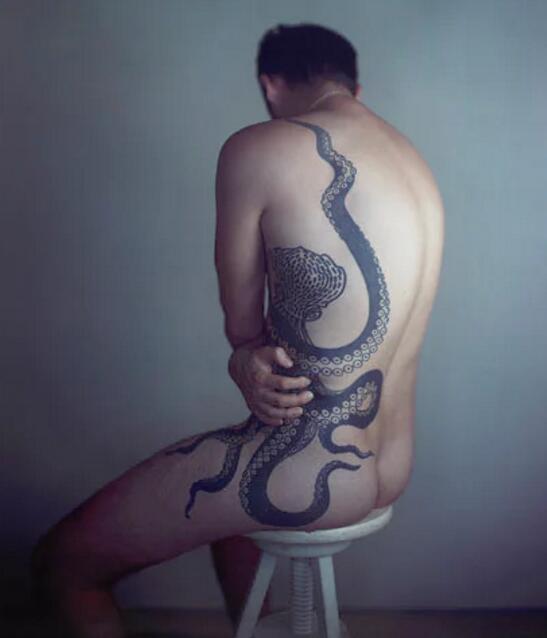托福分数测试HOT
托福课程优惠HOT
托福正价课试听0元
新托福机考练习NEW
0元讲座HOT
新版托福入门课程HOT
托福入门导学NEW
4000人报
托福机经
PDF版
TPO练习
官方授权
资料下载
826套
专业测评
40118人已测
高分经验
1193帖

扫码免费领资料
内含托福全科备考资料
更有免费水平测试及备考规划

扫码关注掌握一手留学资讯
回复XDF免费水平测试
If Cameron and contemporaries such as Oscar Rejlander and Roger Fenton (who took numerous photographs of still-life compositions of fruit and flowers as well as his better known pictures of the Crimean war) were keen that their photographs should reflect their own knowledge of art, the links went both ways. In 1873, Leonida Caldesi published a book of her photographs of 320 paintings in the National Gallery, and her intended audience was not just the public but artists themselves, for whom the photographs were both more accurate and more affordable than engraved reproductions. By 1856, thanks to Fenton's photographs, artists could study classical statues in their own studios.

Richard Learoyd's Man with Octopus Tattoo II (2011) by Richard Learoyd. Photograph: Courtesy of McKee Gallery, New York
It was perhaps in depicting the nude – such as Fenton's bestselling photograph of the discus thrower Discobolus – that photography could repay its debt to art. Hiring a life model was expensive, and engravings were a poor substitute. Delacroix was one artist who "experienced a feeling of revulsion, almost disgust, for their incorrectness, their mannerisms, and their lack of naturalness". He praised instead the painterly aid provided by académies (books of nude photographs) since they showed him reality: "these photographs of the nude men – this human body, this admirable poem, from which I am learning to read". He even helped the photographer Eugène Durieu pose and light his models. And in 19th-century Britain and France, when pornography was illegal, photographs of the nude were in demand from customers who had no artistic interests.
When it came to landscape photography the new medium appeared just as the impressionists were beginning to work in the open air. Some commentators saw photography's real challenge to painting as lying in its ability to capture what the photographer and journalist William Stillman called in 1872 "the affidavits of nature to the facts on which art is based" – the random "natural combinations of scenery, exquisite gradation, and effects of sun and shade". Another practitioner, Lyndon Smith, went further, declaring landscape photography the answer to the "effete and exploded 'High Art', and 'Classic' systems of Sir Joshua Reynolds" and "the cold, heartless, infidel works of pagan Greece and Rome".
本文关键字: 2017年4月15日托福 托福听力背景资料

 资料下载
资料下载
2021-2024托福机经试题|答案|范文下载
发布时间:2024-02-21关注新东方在线托福
回复【XDF】获取
托福全科备考资料大礼包
发布时间:2024-02-21关注新东方在线托福
回复【XDF】获取
托福正价课试听课程包
发布时间:2024-02-21关注新东方在线托福
回复【XDF】获取
托福定制备考规划
发布时间:2024-02-21关注新东方在线托福
回复【XDF】获取
托福TPO免费模考
发布时间:2024-02-21关注新东方在线托福
回复【XDF】获取
托福免费水平测试
发布时间:2024-02-21关注新东方在线托福
回复【XDF】获取
托福写作新题型模拟题+范文汇总[ETS发布]
发布时间:2023-07-30关注新东方在线托福
回复【XDF】获取
2023全年托福机经PDF版下载
发布时间:2023-06-17关注新东方在线托福
回复【XDF】获取
2022全年托福机经PDF版下载
发布时间:2023-06-17关注新东方在线托福
回复【XDF】获取
2022全年写作托福机经整理
发布时间:2023-01-13关注新东方在线托福
回复【XDF】获取
2022年托福考后题目回忆
发布时间:2023-01-13关注新东方在线托福
回复【XDF】获取
托福口语黄金80题附录音
发布时间:2023-01-13关注新东方在线托福
回复【XDF】获取
新东方IBT写作网络课堂录音[.rar]
发布时间:2023-01-13关注新东方在线托福
回复【XDF】获取
21天托福听力提升计划
发布时间:2023-01-13关注新东方在线托福
回复【XDF】获取
不怕跑题偏题,这份写作资料请收好
发布时间:2023-01-13关注新东方在线托福
回复【XDF】获取
托福阅读提分技巧锦囊妙计
发布时间:2023-01-13关注新东方在线托福
回复【XDF】获取
口语拖后腿?因为你缺少这套万能句式资料
发布时间:2019-11-01关注新东方在线托福
回复【XDF】获取
攻破托福听力难关的资料包
发布时间:2023-01-13关注新东方在线托福
回复【XDF】获取
看剧学英语,经典美剧一键获取
发布时间:2019-11-01关注新东方在线托福
回复【XDF】获取
原版外刊资源合集|精心打包整理
发布时间:2019-11-01关注新东方在线托福
回复【XDF】获取

关注新东方在线托福,
回复【XDF】获取大礼包

 推荐阅读
推荐阅读
很多考生对托福听力评分表一知半解,不知道如何根据自己的听力水平和目标分数来制定合理的备考计划和策略。本文将为你揭开托福听力评分表的秘密,告诉你如何提高你的听力分数。
托福听力是托福考试的重要部分,也是很多考生的难点。托福听力的评分标准和评分表是什么?如何根据托福听力评分表提高听力水平?本文将为你详细解答。
新东方在线托福整理了托福听力评分表、托福听力TPO练习网站、听力考试时长和题型等内容,今天带来的是托福听力28题改革后评分标准,帮助大家更好地了解托福听力考试,从而轻松应对托福考试!
新东方在线托福整理了托福听力评分表、托福听力TPO练习网站、听力考试时长和题型等内容,今天带来的是新托福听力28道题评分标准和分数对照表,帮助大家更好地了解托福听力考试,从而轻松应对托福考试!
新东方在线托福整理了托福听力评分表、托福听力TPO练习网站、听力考试时长和题型等内容,今天带来的是2023新版托福评分表28道题及算分标准汇总,帮助大家更好地了解托福听力考试,从而轻松应对托福考试!



 资料下载
资料下载
关注新东方在线托福
回复【XDF】获取
关注新东方在线托福
回复【XDF】获取
关注新东方在线托福
回复【XDF】获取
关注新东方在线托福
回复【XDF】获取
关注新东方在线托福
回复【XDF】获取
关注新东方在线托福
回复【XDF】获取
关注新东方在线托福
回复【XDF】获取
关注新东方在线托福
回复【XDF】获取
关注新东方在线托福
回复【XDF】获取
关注新东方在线托福
回复【XDF】获取
关注新东方在线托福
回复【XDF】获取
关注新东方在线托福
回复【XDF】获取
关注新东方在线托福
回复【XDF】获取
关注新东方在线托福
回复【XDF】获取
关注新东方在线托福
回复【XDF】获取
关注新东方在线托福
回复【XDF】获取
关注新东方在线托福
回复【XDF】获取
关注新东方在线托福
回复【XDF】获取
关注新东方在线托福
回复【XDF】获取
关注新东方在线托福
回复【XDF】获取

 阅读排行榜
阅读排行榜
 相关内容
相关内容